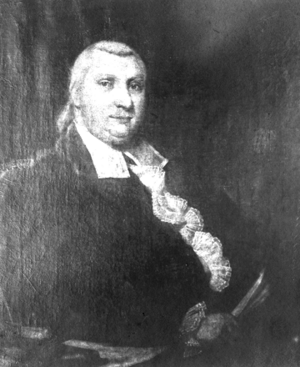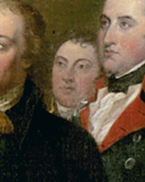Robert Troup facts for kids
Quick facts for kids
Robert Troup
|
|
|---|---|

Portrait of Judge Robert Troup
|
|
| Judge of the United States District Court for the District of New York | |
| In office December 10, 1796 – April 4, 1798 |
|
| Appointed by | George Washington |
| Preceded by | John Laurance |
| Succeeded by | John Sloss Hobart |
| Personal details | |
| Born |
Robert Troup
1757 Elizabethtown, Province of New Jersey, British America |
| Died | January 14, 1832 (aged 74–75) New York City, New York, U.S. |
| Resting place | Green-Wood Cemetery, Brooklyn, New York, U.S. |
| Spouse | Jannetje Goelet |
| Education | Columbia University read law |
| Military service | |
| Allegiance | |
| Branch/service | |
| Years of service | 1775–1780 |
| Rank | Lieutenant Colonel |
| Unit | Hearts of Oak |
| Battles/wars | Battles of Saratoga |
Robert Troup (1757 – January 14, 1832) was an important figure in early American history. He was a brave soldier during the American Revolutionary War, fighting for America's independence. Later, he became a United States district judge, helping to make sure laws were fair.
Troup was part of the famous Battles of Saratoga, which was a major turning point in the war. He was even there when the British General John Burgoyne surrendered!
Contents
Early Life and Learning
Robert Troup was born in 1757 in a place called Elizabethtown, New Jersey. Back then, New Jersey was still a British colony in North America.
He went to King's College, which is now known as Columbia University. He graduated in 1774. While at college, he shared a room with Alexander Hamilton, who would become a very famous Founding Father. After college, Troup studied law with a well-known lawyer named John Jay.
Serving His Country
When the American Revolutionary War began, Robert Troup quickly joined the fight. He became part of a volunteer group called the Hearts of Oak in New York.
- He started as a second lieutenant in 1775.
- Many of his college friends, like Alexander Hamilton, also joined this group.
- In 1776, the Hearts of Oak became part of the Continental Army, which was America's main fighting force.
Captured by the British
On August 27, 1776, Robert Troup was captured by British soldiers during the Battle of Long Island. He was held on a prison ship called HMS Jersey. Later, he was moved to a prison in New York City. He was finally set free on December 9, 1776.
Returning to Battle
After being released, Troup rejoined the Continental Army. He became a captain and was promoted to major in 1777.
- In August 1777, he became a special assistant, called an aide-de-camp, to General Horatio Gates.
- He was promoted to lieutenant colonel in October 1777.
- As General Gates's aide, he played a role in the Battles of Saratoga.
- He was present when General John Burgoyne surrendered on October 17, 1777.
- Robert Troup was even shown in a famous painting from 1821 called Surrender of General Burgoyne.
After his time on the battlefield, Troup worked for the government. He was secretary for the Board of War starting in 1778. He also worked for the Board of Treasury from 1779 to 1780.
Life After the War
After the war, Robert Troup finished his law studies. He worked as a lawyer in Albany, New York, from 1782 to 1783. Then, he moved his law practice to New York City from 1784 to 1796.
- He was a member of the New York State Assembly in 1786.
- He also worked as a court clerk for the United States District Court in New York from 1789 to 1796.
Becoming a Judge
In 1796, President George Washington chose Robert Troup to become a judge for the United States District Court for the District of New York.
- The United States Senate approved his appointment on December 10, 1796.
- He served as a judge until April 4, 1798, when he decided to resign.
After leaving his judge position, Troup went back to being a private lawyer in New York City. He also managed large land estates in western New York for a wealthy British man named Sir William Pulteney.
Robert Troup remained a close friend of Alexander Hamilton throughout his life. They had been roommates in college and served together in the military.
Family Life
Robert Troup lived for many years in Geneva, New York. He was married to Jannetje Goelet. They had four children together:
- Charles Troup
- Robert R. Troup
- Louisa Troup
- Charlotte Troup
Robert Troup passed away on January 14, 1832, in New York City. He was buried in Green-Wood Cemetery in Brooklyn.
Legacy and Honors
Robert Troup helped start the New York Manumission Society in 1785. This group worked to slowly end slavery in New York and protect the rights of free Black people. Even though he owned enslaved people himself, he led the first meeting of the Society. He and Alexander Hamilton tried to make a rule that members of the Society had to free their own enslaved people, but it didn't pass. Troup eventually freed four of his enslaved people between 1802 and 1814.
Two places in New York were named after Robert Troup and his family:
- The town of Troupsburg, New York, was named after him.
- The town of Charlotte, near Rochester, New York, was named by Troup in honor of his daughter, Charlotte.
Images for kids
-
Surrender of General Burgoyne, an 1821 painting by John Trumbull, shows Troup (8th from right).



